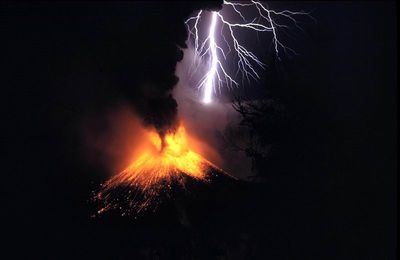
FAIR is a non-profit organization dedicated to providing well-documented answers to criticisms of the doctrine, practice, and history of The Church of Jesus Christ of Latter-day Saints.
FAIR Answers—back to home page

Some argue that the "three days" of "darkness upon the face of the land" in the New World following Christ's death is implausible. There are also a number of references to the destruction in the New World that accompanied Christ's death to "the whole Earth." However, When the Book of Mormon says “the whole Earth” it does not actually mean the entire planet, but rather every place within the local people’s experience.
Note that in the gospel of Luke is says that Caesar taxed "all the world" (Luke 2꞉1
). But he clearly could not have taxed anyone outside the Roman Empire, which, large as it was, was not "all the world." It certainly did not include India or China, or much of anywhere else east of Judea, nor most Arabia to the south and the vast majority of the African continent--let alone the Americas, obviously, which they did not even know. Likewise, when Jesus commanded the apostles to preach the gospel throughout "all the world" (Mark 16:15) there no evidence they went beyond the Roman Empire either.
The phrases "all the world" and "the whole earth" in the scriptures and other ancient sources generally lack the global perspective we have today, and are in fact hyperbolic, referring to a more limited region
The Book of Mormon 3 Nephi 8꞉5-25
provides a detailed description consistent with a massive volcanic and seismic eruption. Such details are precise for both ancient and modern accounts, though they would have been unknown to Joseph Smith.
Remarkably, one of the models most favored by LDS scholars (Sorenson's Mesoamerican model) has candidate eruptions which are largely restricted to the proper time period.

The three days of darkness is consistent with a period of intense volcanism. This explanation of the darkness has been particularly popular among those who advocate a limited geographical model of the Book of Mormon. Most LGT models place Book of Mormon lands in central America; this area is well-known for active seismic activity.
One author suggested:
) were volcanic ash and dust stirred up by the quaking of the ground.[1]

The inability to ignite the exceedingly dry wood is interesting in view of the fact that a few people are also described as dying from suffocation during the period of destruction which preceded the period of darkness (3 Nephi 10꞉13
). This suggests that in some regions the concentration of dense volcanic gases (carbon dioxide and sulfur dioxide) at ground level was sufficient to prevent igniting of the kindling and to cause suffocation. The uncle of Pliny died of suffocation as a consequence of a volcanic eruption.
James Baer notes that volcanic eruptions could have accompanied the violent earthquake described in 3 Nephi. He notes that these would have made the atmosphere dark with dust and cinders and would have released carbon monoxide, carbon dioxide, and sulfurous gases, which would have been suffocating and could have made fire kindling impossible.
Another mechanism, however, seems an equally likely explanation of the inability to ignite the dry tinder. If one assumes that sparks from flint were the common method of starting fires, then the heavy ash fall could have been effective in preventing ignition. This heavy ash fall also offers a likely explanation for the terms mist of darkness and vapor of darkness used in 1 Nephi 12꞉4–5
.[2]
Given the wide variety of geographic models proposed for the Book of Mormon, there is obviously not evidence of volcanism in all areas, especially at the proper (i.e., at around AD 30, at Christ's death). (If the volcanic hypothesis for the three days' darkness is true, this provides one data point which can exclude many models, including a hemispheric or exclusively North American model.)
However, Sorenson's Mesoamerican model has been noted to have some interesting features in this regard: volcanoes do exist in the proper area, and these volcanoes have been shown by modern dating to have erupted only during two periods during the past 8600 years (3% of the time):
Thus, Sorenson's model could have been easily disproven by these data, but was not.[3]
Furthermore, ice core data is consistent with a major volcanic event at the time of Christ's death, within the margin of error provided by the dating measurements, though it is not at present possible to determine the location of these eruptions.[4]
Notes

FAIR is a non-profit organization dedicated to providing well-documented answers to criticisms of the doctrine, practice, and history of The Church of Jesus Christ of Latter-day Saints.
We are a volunteer organization. We invite you to give back.
Donate Now